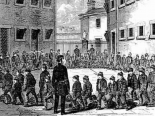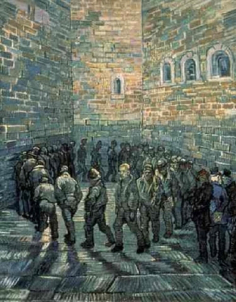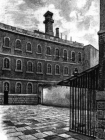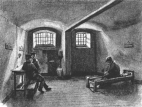





Docklands and the Thames,
Victoria Park to Paternoster
Square. Take a nostalgic
trip back to the East End in
the 1950’s or a stroll around
the Square Mile of the City
of London. It’s all here at
barryoneoff.co.uk
Copyright 2002 - 2024 ©Barry Carter. All rights reserved
Unlike Today
The sentences handed down by the courts were severe, even for the most petty of offences. It seems that the more serious the crime, the better off you were. The odd reasoning behind this was that you had to serve your sentence in full. If you were given a long jail sentence your body would not survive the hard labour imposed on the short term inmates for the duration of your stay. Therefore, although still not a pleasurable experience, you had a less tougher time than the petty criminals. This prevented you cheating the system by dropping down dead through exhaustion or malnutrition before your time had been served. Quite different to the luxury offered to offenders today! Poverty was the main causes of the need for so many prisons. People stealing food to satisfy their hunger, or a pair of boots because they had none. All this meant that they had to be taken off the streets and incarcerated for the most minor of offences. Out of sight, out of mind. The real culprits, the business men and middle to upper classes, who did nothing to remedy the situation sat in the comfort of their fine mansions, safe in the knowledge that the starving wretch who had stolen a handful of plums from his garden, was safe behind bars. No longer a threat to humanity.Tothill Fields Prison
On the site of the present Westminster Cathedral stood a correctional facility called Tothill Fields Prison. This was said to be a more desirable place to be incarcerated than most others due to the more humane (in comparison) treatment handed out to its inmates. Maybe this is the reason it only lasted for a period of fifty years. Or was it because the land was wanted for the building of the cathedral? The main punishment seemed to be the rule of silence, prisoners were not allowed to converse with each other. The other main form of punishment was to withhold their food, and the likely reason for this to be imposed upon you was being caught talking to another prisoner. According to records of the time, a whipping had only been authorised twice between 1851 and 1855, for what crimes I am unaware. After 1850 Tothill was used only for women, and boys under 17 years old. Henry Mayhew visited the prison in 1861 and in his book, "Criminal Prisons of London", praises the staff for ensuring discipline without the need for physical punishment. Most of the inmates were in their early teens but children from the age of five years and upwards were sentenced to be detained there.More Prisons Needed
The cells were individual in most early prisons so that any time you had to yourself (which was very little), was spent entirely in isolation. Many prisoners were driven to insanity because of the tasks they were compelled to carry out, and the endless solitude. Alone in a cell turning the "crank" handle from morning till night. Because of the overcrowding, prison ships were also made use of to house the many convicts for whom there was no room. The Government had to start funding a scheme to build even more jails in London. The first of these, to be opened in 1821, was the The National Penitentiary, at Millbank. Others were to follow in due course. Much prison space was taken up by people who owed money. Their sentences were as long as it took them to pay back the debt! Debtors who were not housed in the prison at Newgate were sent to the Fleet prison, or the Marshallsea.Newgate Prison
As black as Newgate’s knocker. That’s what my mother would say about the state of my hands after playing on the bomb site as a kid. I didn’t have a clue what or where Newgate was. There had been a prison at Newgate since 1188, with rebuilding carried out in 1770. It was only 12 years after this, in 1782, that a new prison was completed, the former being so badly damaged in the Gordon Riots of 1780. It takes its name from one of the old walled City gates. It was London’s main prison, and as well as housing debtors and criminals, it was the last port of call for all prisoners under sentence of death. There was also a women’s section. If you were a wealthy felon, you were housed in the comfortable section of the jail, for which you would have to pay. Some even paid others to carry out their sentence for them! The gallows were erected in 1783. Before that, public executions were were always held at the infamous Tyburn. Newgate was host to 1,167 hangings from this date, the last one being in 1902.The Death Penalty
Up until the mid-nineteenth century there were many offences that could incur the death penalty. Not just murder. Many were hanged for comparatively minor crimes. Masses of people used to assemble outside Newgate to watch the executions, the wealthy even paid for ringside seats. After 1868 all hangings were carried out inside the prison, away from public view. In 1877 it ceased to be used for carrying out sentences imposed by the courts. It was to house only prisoners waiting to go to trial, and for those who had received the death penalty. This made the task easier, as all major crimes were to be tried at the Old Bailey, which was then, right next door to the prison. In 1902, after George Wolfe, the last man to be hanged there, met his death on May 6th, Newgate was closed. Pentonville jail became the home of the existing male prisoners. The women were transferred to Holloway prison. Newgate jail was demolished, and the Central Criminal Court built on its site. The court is still world famous, and kept its more familiar name of The Old Bailey.Charles Dickens
Charles Dickens wrote about Newgate when he was submitting articles to periodicals under the name of ‘Boz’, in his early days as a writer. After a short description of the women’s quarters and the schoolhouse for the under 14’s, he describes the section where the men were housed: “The prison was made up of large day rooms, referred to as ‘wards’. He mentions that there was a separate section for housing of the ‘more respectable type’ of prisoner. I take this to mean the ones with the means to pay for the extras! He goes on to say: In the general prison area, men sat idle in front of the fire, paced up and down, or stared out of the window wishing they were on the outside. Visitors had to stand inside a cage in the yard, with enough distance between them and the prisoners to prevent any bodily contact. Some of these men were already under sentence of death, and at five o’clock would be taken to their solitary cells for lock up. There were three landings of these cells, and they would remain there until seven the next morning. On the eve of the execution they would spend a full 24 hours in this cell, waiting to face the gallows. Dickens also tells of the prison chapel situated in one of the yards. It had special section of pews under the pulpit, known as the ‘dock’, where those about to be hanged would sit during the service. In earlier times, they were accompanied by the coffin they were to be buried in”.Minor offences in Tothill
Although the majority of inmates were there for theft, it is hard to believe that even in those days knocking on a door and running away could get you locked up. As this was one of my favourite pastimes as a child, I am grateful to have been born in the following century! There was also a women’s section of the prison, and facilities for those with young children, to look after them, when not at work. This work was at least productive, unlike the pointless hard labour enforced in other institutions. There were oakum picking, knitting, and laundry work, among others. One of the problems, which may have contributed to the closure of the prison was the amount of inmates returning after completion of their sentence. Bear in mind that these people, when on the outside, had mainly a life of misery. Without food or shelter and no hope of improving their lot. It must have been tempting to throw a stone to break a window, and wait to be arrested. It was suspected at the time that this was the case. Knowing the conditions inside Tothill were not brutal, and that they would be given a roof over their heads and regular meals, people were purposely being arrested for minor offences.Coldbath Prison
Coldbath Fields House of Correction was built in Clerkenwell. The deportation of convicts had stopped in 1840 causing a shortage of prison space. Coldbath was used to take the overflow from London's notorious Newgate prison. It took its name from a nearby spring which, I dare say, was part of the original clerks well, where Clerkenwell gets its name. Conditions here were not as lenient as Tothill. The work prisoners had to undertake was hard, both physically, and mentally. Worst of all, it was completely pointless. Merely something to keep prisoners busy and exhausted. The crank was a handle attached to a revolving drum with a counter that clocked up the revolutions. You would be made to place both hands on the handle and turn it, and turn it, and turn it! Sometime for periods of eight hours a day. There was no cheating, because of the counter, and you had to make your allotted number of revolutions. This drum was not connected to any kind of industrial machinery or power generator of any kind, so it was totally non-productive.The Screws
If the warder wanted to make it tougher on you, for some reason, he could simply tighten the screw on the crank to make it harder to turn. This is where the slang term "Screw", meaning prison officer, originated. One of the worst forms of punishment was the treadmill. Once again, not to move water, or grind flour, but simply punishment to pass the time. It was a cruel set up, the way it was designed to turn at a certain speed. Whoever thought of this little gem must have had a warped mind. As if it wasn't bad enough having to tread what must have seemed like an endless flight of stairs, the speed was governed to make it even harder. It turned at a pace that allowed the shortest possible time to push with your foot. So as soon as you put the pressure on one foot, the tread moved out of reach, forcing you to get your other foot on the next tread and immediately push with that one. This meant that neither leg ever got the slightest moments rest. It is impossible to imagine what it must be like for hours at a time on this device. It became known among prison inmates as the "Cock-chaffer", for obvious reasons! "Treading the Wind" was phrase used to describe your turn on it.THE VICTORIAN PENAL SYSTEM





















